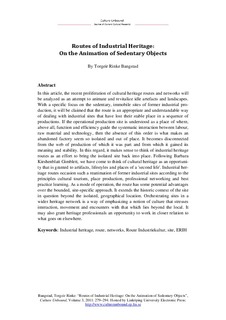| dc.contributor.author | Bangstad, Torgeir | |
| dc.date.accessioned | 2019-10-11T08:47:01Z | |
| dc.date.available | 2019-10-11T08:47:01Z | |
| dc.date.created | 2012-01-04T16:38:10Z | |
| dc.date.issued | 2011 | |
| dc.identifier.citation | Culture Unbound. Journal of Current Cultural Research. 2011, 3 279-294. | nb_NO |
| dc.identifier.issn | 2000-1525 | |
| dc.identifier.uri | http://hdl.handle.net/11250/2621515 | |
| dc.description.abstract | In this article, the recent proliferation of cultural heritage routes and networks will be analyzed as an attempt to animate and revitalize idle artefacts and landscapes. With a specific focus on the sedentary, immobile sites of former industrial production, it will be claimed that the route is an appropriate and understandable way of dealing with industrial sites that have lost their stable place in a sequence of productions. If the operational production site is understood as a place of where, above all, function and efficiency guide the systematic interaction between labour, raw material and technology, then the absence of this order is what makes an abandoned factory seem so isolated and out of place. It becomes disconnected from the web of production of which it was part and from which it gained its meaning and stability. In this regard, it makes sense to think of industrial heritage routes as an effort to bring the isolated site back into place. Following Barbara Kirshenblatt Gimblett, we have come to think of cultural heritage as an opportunity that is granted to artifacts, lifestyles and places of a ’second life’. Industrial heritage routes occasion such a reanimation of former industrial sites according to the principles cultural tourism, place production, professional networking and best practice learning. As a mode of operation, the route has some potential advantages over the bounded, site-specific approach. It extends the historic context of the site in question beyond the isolated, geographical location. Orchestrating sites in a wider heritage network is a way of emphasizing a notion of culture that stresses interaction, movement and encounters with that which lies beyond the local. It may also grant heritage professionals an opportunity to work in closer relation to what goes on elsewhere. | nb_NO |
| dc.language.iso | eng | nb_NO |
| dc.publisher | Linköping University Electronic Press | nb_NO |
| dc.rights | Navngivelse-Ikkekommersiell 4.0 Internasjonal | * |
| dc.rights.uri | http://creativecommons.org/licenses/by-nc/4.0/deed.no | * |
| dc.title | Routes of Industrial Heritage: On the Animation of Sedentary Objects | nb_NO |
| dc.type | Journal article | nb_NO |
| dc.type | Peer reviewed | nb_NO |
| dc.description.version | publishedVersion | nb_NO |
| dc.source.pagenumber | 279-294 | nb_NO |
| dc.source.volume | 3 | nb_NO |
| dc.source.journal | Culture Unbound. Journal of Current Cultural Research | nb_NO |
| dc.identifier.cristin | 876857 | |
| dc.description.localcode | Under a (CC BY-NC) license. | nb_NO |
| cristin.unitcode | 194,62,60,0 | |
| cristin.unitname | Institutt for språk og litteratur | |
| cristin.ispublished | true | |
| cristin.fulltext | original | |
| cristin.qualitycode | 1 | |

